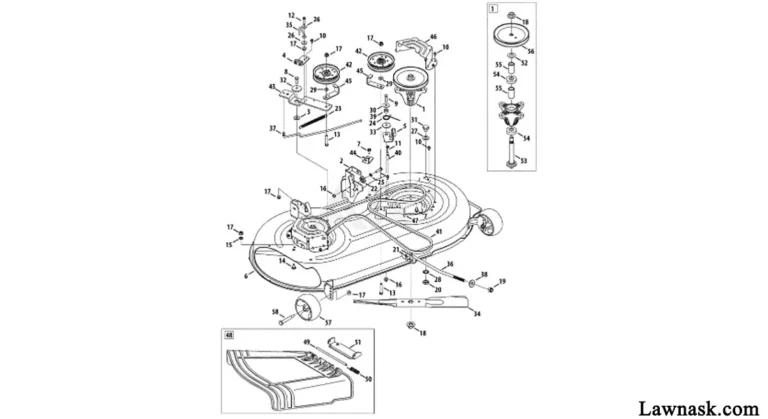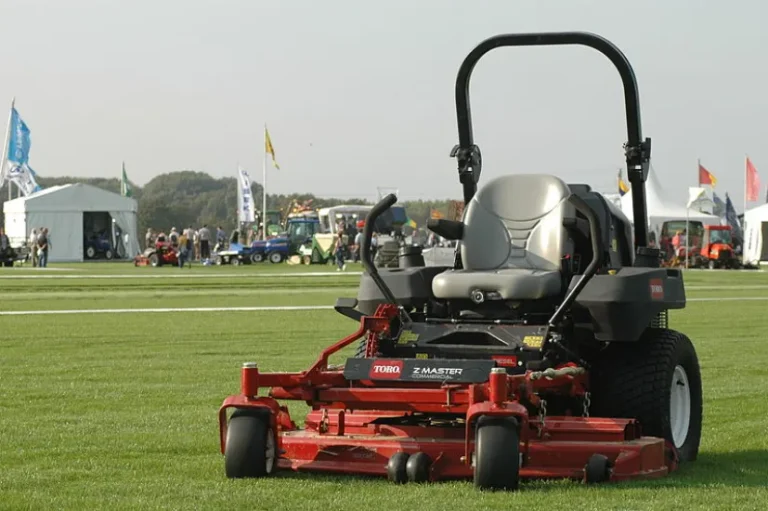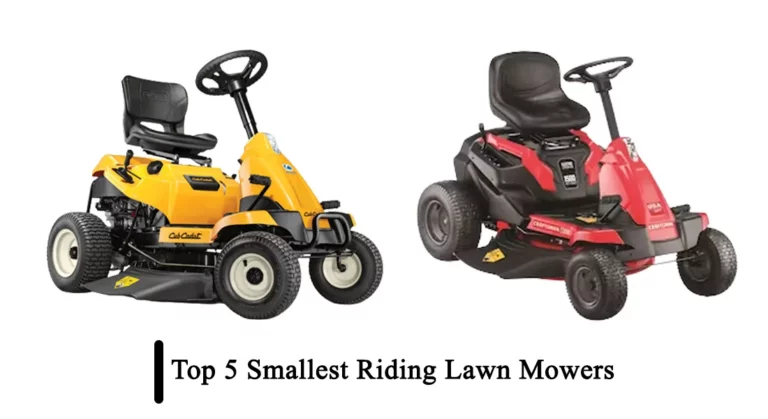Type of Oil to Use in Husqvarna Riding Mowers (A Complete Guide)
Are you using the right oil in your Husqvarna riding mower? If not, then you can consider this article as a complete guide. Even though different models, engines, and other components may have vastly different oil requirements, you can use some common oil types for your Husqvarna riding mowers.
The most common type of oil for Husqvarna riding mowers is SAE 30 and SAE 10w-30. SAE 10W-30 is compatible with some Husqvarna mowers, but not all. Other recommended oils are SAE 5W-30 and Vanguard 15W-50.
This article provides information on the type of oil to use in Husqvarna riding mowers. Completely read this article to learn more about it.

What Kind of Oil can be used on a Husqvarna Riding Mower?
To keep your Husqvarna lawn mower running smoothly, you can choose from one of three different oils. You can choose from the given three types of oil for your Husqvarna riding mower-
Note: The temperature and engine type are the two most important factors in determining whether or not the oil will work.
Conventional/ Mineral-Based Oil
Conventional oils typically operate most effectively within a limited temperature range. They are refined from crude oil that is extracted from the ground; hence they are a mineral-based product.
If you ride an older Husqvarna with a less sophisticated engine, this is a fantastic oil for your vehicle.
The main benefit is that it is cheaper than most synthetic oils, typically costing just around half as much. The age of your mower could be another factor in favor of the previous norm.
Synthetic Oil
It is synthetically manufactured with chemical compounds. Superior performance and engine safety are two of the main goals of developing this type of oil. It’s ideal for newer riding lawnmowers by Husqvarna because it outperforms more traditional oils.
Synthetic oil is more expensive and may not be essential for your older engine.
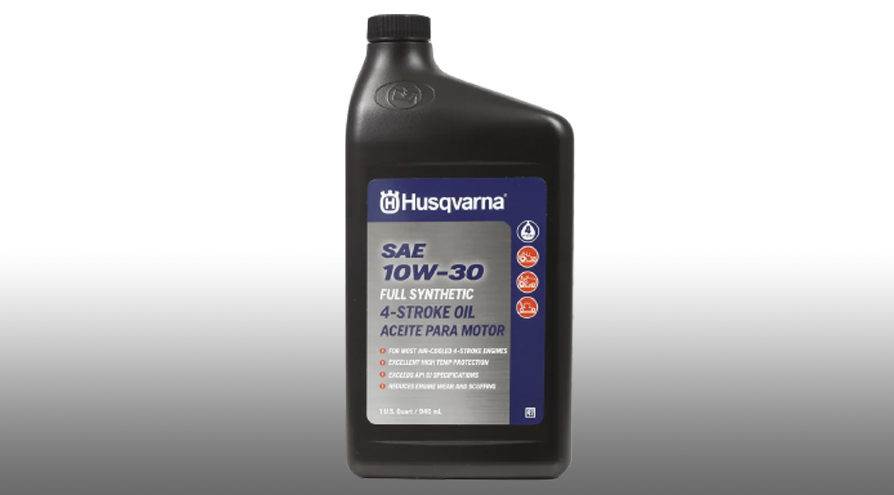
Full Synthetic Oil
Full Synthetic Oil is the most recent form of oil and consists entirely of synthetic compounds. It provides the most effective performance and safety on Husqvarna vehicles, particularly in extreme temperatures.
Related Post: Riding Mower Leaving a Strip in the Middle (Reasons and Solutions)
How Often Should You Change the Oil in Your Husqvarna Riding Mower?
Lawnmowers have a unique oil change interval compared to other vehicles. Oil changes are routinely scheduled either at predetermined mileage intervals or at regular intervals of time in the case of motor vehicles.
Lawnmowers work by hours or by season. Husqvarna suggests changing out the oil after 25 hours of use or at the beginning of each new season. In unclean, dusty conditions, you may need to change the oil more frequently.
Best Oil to Use in Husqvarna Riding Mowers
Here is the list of the best types of oil to use in Husqvarna riding lawnmowers available in the market:
- SAE 30
- SAE 10w-30
- SAE 5w-30
- Vanguard 15w-50
A Comparison Chart of the Best Types of Oil Use in Husqvarna Riding Mowers
| Features | SAE 30 | SAE 10w-30 | SAE 5w-30 | Vanguard 15w-50 |
| Type of Oil | Monograde Motor Oil | Synthetic Oil | Synthetic Oil | Full Synthetic Engine Oil |
| Operating Temperature | More than 40° F (5° C) | -25°C (-13°F) to 30°C (86°F) | –30°C to 35° | 20°F to 130°F |
| Grade | Single-grade | Multi-grade | Multi-grade | Multi-grade |
| Price (Per Quart) | $10-$15 | $5-$10 | $10.49 | $12.40 |
SAE 30 Oil
One of the most popular oils for Husqvarna lawnmowers is SAE 30 oil. The name comes from a scale used to categorize oils by viscosity by the Society of Automotive Engineers.
- SAE 30 oil is commonly used in smaller engines
- It is a simple and affordable oil of a single grade.
- The viscosity rating of SAE 30 oil is 30.
- When operating your motor in temperatures above 40 degrees Fahrenheit (4 degrees Celsius), SAE 30 is the best option.
Lawnmowers benefit greatly from SAE 30 oil, which is a medium-weight oil that remains stable at high temperatures. The heavy nature of this lubricant makes it ideal for use on engine parts that can become very hot during operation.
This oil is suitable for small-engine vehicles such as those found in lawnmowers, snow blowers, and tractors.
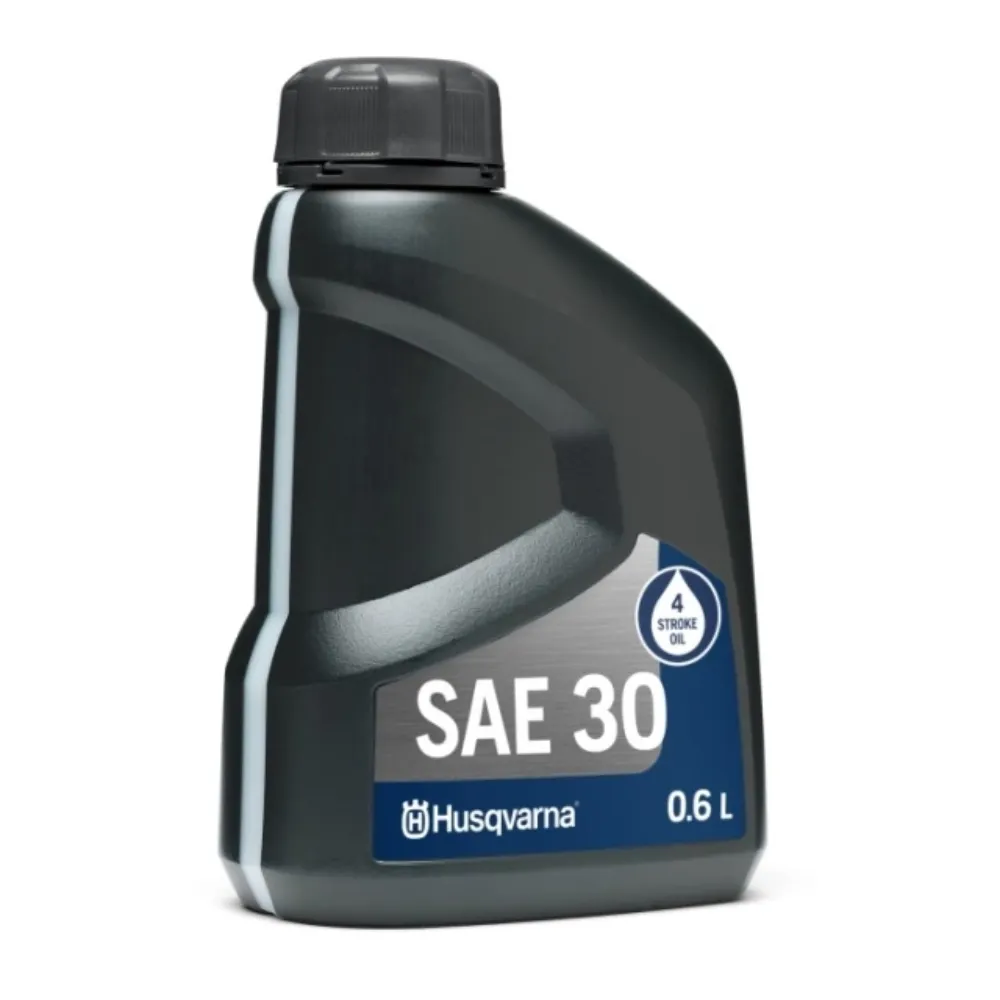
- Husqvarna SAE 30 Mower Engine Oil
Mowers with engines ranging from 2 to 5.5 horsepower will benefit most from SAE 30 4-Stroke Engine Oil.
This not only outperforms API SJ standards, but it also functions well in most air-cooled 4-stroke engines. This oil also reduces wear and scuffing.
SAE 10w-30 Oil
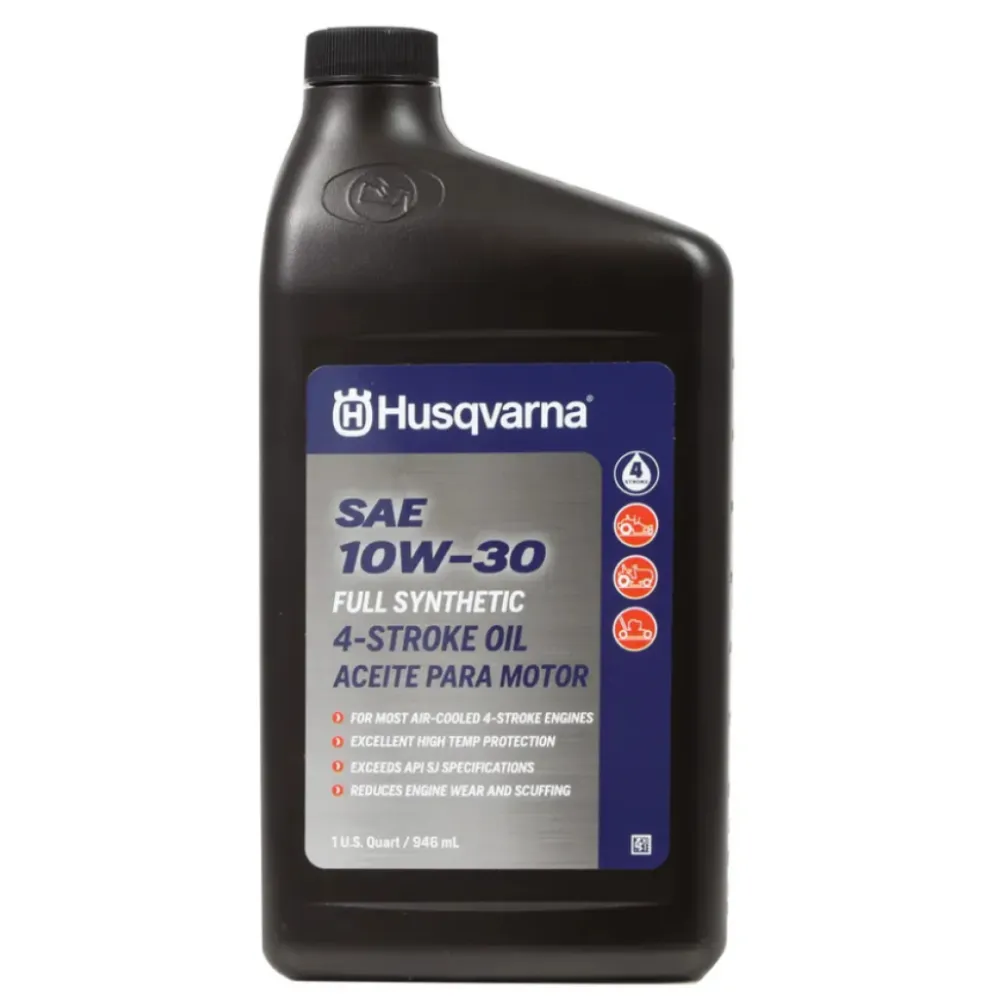
The SAE 10w-30 oil indicates when the engine is cold, the viscosity is 10W, and when it’s hot, it’s 30W.
- The thinner 10W-30 oil is better suited to colder temperatures.
- Because of its greater viscosity, it also serves as a wear barrier.
- The engine parts are kept from overheating thanks to the lubrication provided by 10W-30 oil.
The 10W-30 engine oil can be used in a wide variety of vehicles. It has a wider temperature range for operation than 10W-40 oils do. It’s great for cold starts and can significantly lessen the amount of time an engine needs to warm up.
Most gasoline and diesel engines may utilize 10W-30 motor oil. A region with long, hot summers and moderate winters is perfect for this sort of motor oil. It is perfect for heavy-duty vehicles.
- Husqvarna Full Synthetic 10-W-30
Husqvarna’s Full Synthetic 10-W-30 4-Stroke Engine Oil is a high-quality product made for heavy-duty industrial applications.
It is perfect for large-scale mowing equipment including tractors and commercial zero-turn and walk-behind mowers.
This oil is also great resistance to heat, and less engine scraping and wear as a result. Suitable for most 4-stroke engines that use air for cooling.
SAE 5w-30 Oil
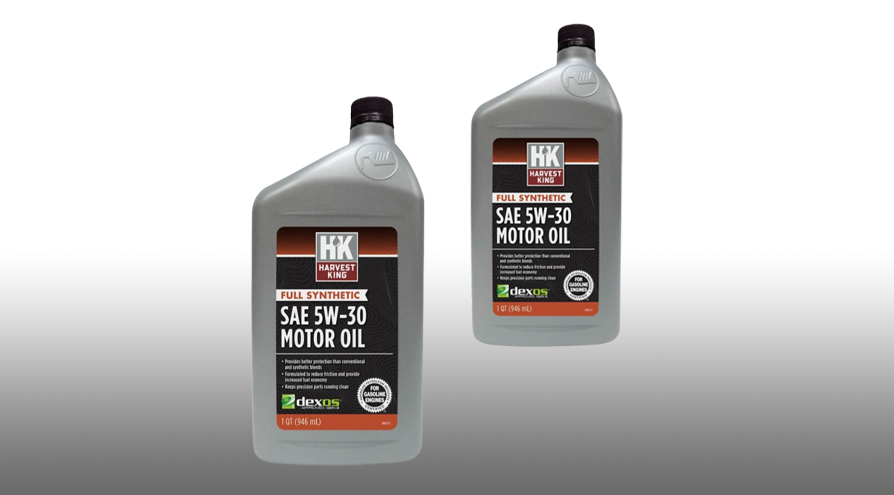
The SAE 5w-30 oil indicates 5W being the low-temperature viscosity and 30 being the high-temperature viscosity at 100 degrees Celsius. The lower the number preceding the W, the greater the oil’s low-temperature flow.
This oil is for light-duty use in passenger cars and light trucks, for engines that ain’t under excessive pressure, and for drivers who experience frequent temperature fluctuations, as it is less susceptible to thermal breakdown.
Some individuals may switch to this oil throughout the winter because it provides superior engine protection and aids in preventing engine deposits at cooler temperatures.
- Husqvarna 5W-30 Synthetic Blend Engine Oil
It is a semi-synthetic 5W-30 4-Stroke lubricant for most 2-stage 4-Stroke snow throwers. In low temperatures, this oil performs admirably.
Vanguard 15w-50

Vanguard 15W-50 is a high-quality synthetic oil that offers several features that make it a desirable choice for engine lubrication. One of the key benefits of this oil is that it is 100% synthetic, meaning that it is made from chemical compounds rather than crude oil.
In Vanguard 15W-50, Zinc is used as a wear inhibitor, helping to reduce friction and extend the life of your engine. This is particularly important in high-performance engines that are subjected to high stress and wear.
Vanguard 15W-50 also has a wide temperature range, making it suitable for use in a variety of conditions. It can be used in temperatures ranging from 20°F to 130°F, making it a versatile choice for drivers who live in areas with fluctuating weather patterns.
- Briggs & Stratton 15W-50 Full Synthetic Vanguard Engine oil
This oil optimizes outdoor power equipment. This oil is designed for high-temperature commercial equipment and continuous-use engines. This oil is ideal for high-temperature commercial cutting machines and other demanding tasks.
Related Post: Craftsman Riding Mower Won’t Start (6 Causes & Fixes)
How to Choose the Right Type of Oil to Use in Husqvarna Riding Mowers?
When selecting oil for your Husqvarna riding mower, it is essential to consult the owner’s manual for manufacturer-specific recommendations.
You should choose your oil type for Husqvarna riding mower based on the:
1. Engine Type
The engine type is an important factor in determining the appropriate oil type for a riding mower. Different engines have different requirements for oil viscosity, additives, and performance characteristics.
Using the wrong type of oil can potentially damage the engine or reduce its lifespan. Mowers made by Husqvarna can be powered by either a two- or four-stroke motor.
Four-stroke engines can run on regular gasoline straight from the pump. Motor oil must be poured into the crankcase as a separate step before the engine can be started. In most situations, 10W-30 is the correct stuff for four-stroke engines, but check your owner’s handbook to be sure.
Two-stroke motors have unique oiling needs compared to four-stroke ones. Two-stroke motors use both gasoline and oil in their combustion process.
2. Oil Capacity
The engine’s oil capacity specifies how much oil it can run on. Overfilling or underfilling the oil might damage the engine, so it’s crucial to get it just right.
Husqvarna’s riding mower usually takes 20 ounces of motor oil to keep the engine running smoothly. Husqvarna suggests using an oil with an API classification of SG-SL.
3. Viscosity
Several grades of motor oil exist, each characterized by a unique combination of viscosity.
A multi-grade or single-grade oil is recommended for riding mowers since it functions effectively in both high and low temperatures. Depending on the model of your mower and the weather conditions in which you want to mow, the suggested viscosity will change.
4. Temperature
It is an essential consideration when selecting the type of oil for your riding mower. The mower’s operating temperature can impact the oil’s viscosity.
Related Post: 5 Common Troy Bilt Riding Mower Problems: How to Fix Them
How to Change the Oil in a Husqvarna Riding Mower?
You can change the oil on your Husqvarna easily by following the given steps below-
Step 1: Gather all of the oil-changing supplies you will need
First, gather up everything that will be needed for the oil change:
The oil type for your car’s engine. For further details, please refer to the user guide. The standard SAE 30.
- A container for collecting oil
- Oil dipstick/fill plug
- A spouting device
- Pieces of cardboard made of cloth or paper
Step 2: Get the Husqvarna mower ready
Place the mower where any oil spill may be cleaned up easily. It is possible for oil to leak onto the ground during removal.
The Husqvarna lawnmower should be left to run for at least 15 minutes. That will get the oil nice and hot, which will make changing it much simpler. The oil level may be easily checked.
Step 3: Release the oil by opening the drain valve
- Locate the drain valve, unscrew its lid, and remove it. Then, open the drain’s discharge valve.
- Slowly drain the oil from your Husqvarna Riding Lawnmower by tipping it over into a container.
- Try to move/shake the mower to remove any residual oil from the engine.
- Once the old oil has been thoroughly drained, close the valve and replace the cap.
- Now, empty the used oil into a container that can be sealed.
- With or without the container, this Oil must be discarded in a suitable location.
Step 4: Another way to drain the oil involves the use of an oil pump
The alternative way to remove oil is to use-
- A mechanical or electrical device is used to pump oil.
- Use an oil removal tool (oil suction machine) to remove the oil.
Step 5: Put in new motor oil
You may now add new oil to the Husqvarna Riding Lawnmower. The newly extracted oil is a lighter brown or golden hue than the old oil, which had a darker brown.
- Place the funnel in the filling compartment.
- Slowly pour the oil for the engine into the funnel. Put a stop to further additions and use the dipstick to verify the level.
Note: It’s important to keep doing this until the oil is almost at the top. Every time you check the oil level, you should also clean the dipstick.
- It’s important not to overfill the oil. In the event of an overfill, an oil pump can be used to drain the excess.
Step 6: Verify the Oil Capacity
Re-insert the dipstick to check the oil level. The dipstick has a thick oil film when removed. Your mower requires oil if it’s low. Instead of topping off, change the oil if it’s been a while.
Add oil if needed. Remove oil if the level is too high.
Step 7: Start your Husqvarna lawnmower
With fresh oil, your Husqvarna Riding lawnmower is ready to go.
- Tighten the oil cap.
- Start the engine normally and test your mower.
- After operating for a bit, check the oil level again.
Final Words
The appropriate oil for your Husqvarna riding mower ensures engine protection, performance, and longevity. While choosing oil, consider engine type, capacity, temperature, and manufacturer recommendations.
By following the manufacturer’s recommendations for oil changes and the oil indicated in this article, you can ensure that your riding mower performs smoothly and efficiently, lowering the chance of damage and extending its life.
Related Posts:

